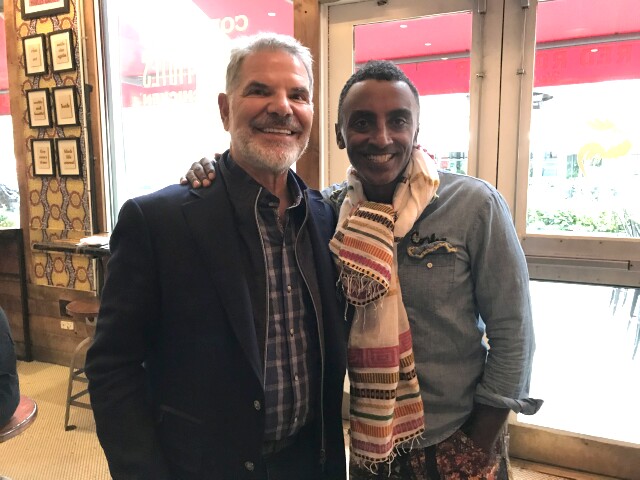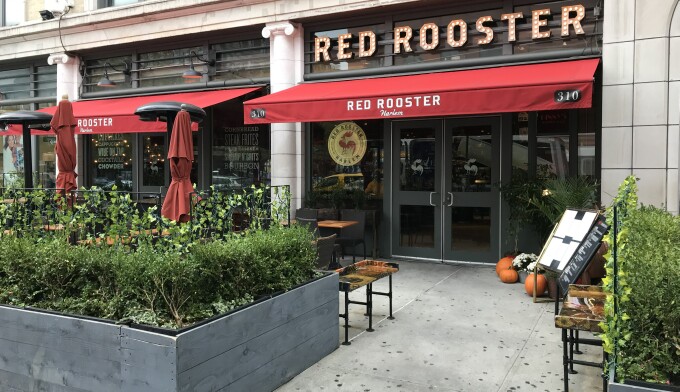Lunch at Michael’s (at Red Rooster) with Marcus Samuelsson

It's a gray day in New York City, but up in Harlem at Red Rooster, the flagship restaurant of world-renowned chef Marcus Samuelsson, a bright energy fills the room, much of it radiating from the man himself. A winner of Bravo’s Top Chef Masters, a judge on Food Network’s Chopped and Iron Chef America (among others), the owner/operator of 15 restaurants and author of seven books, including the digital cookbook Our Harlem, Samuelsson (with a little help from his team) arranged a Lunch at Michael’s-style lunch with Jack Myers and me at what has become in its nine years of operation a definitive Harlem landmark. Remarkably, he still manages to spend “about half my time” in the kitchen, he said. “It’s about connecting with the three levels of communities; the staff, the purveyors and our customers. In a great restaurant all three are lined up and connected. You don’t have to say a lot. It just happens.”
We were there to talk about yet another of his television projects, the PBS docuseries No Passport Required, the second season of which debuts on January 20. (No Passport Required is produced for PBS by Eater and Vox Media Studios.) As we sampled several of his savory signature dishes, Samuelsson frequently referred to the storytelling that surrounds food, the power of food to bring people together, the opportunities it provides for learning and communicating, and how his humble upbringing in Sweden set him on a path to the life he enjoys today.
Throughout, it became clear that Samuelsson has many passions, all of them surrounding people and food, and that it would be impossible to isolate one over the other as his special favorite. As evidenced by his enthusiasm for No Passport Required, however, nothing pleases him more than having the opportunity to tell stories about people with a passion for preparing food and to share those stories with as many communities as possible in the same way that those chefs share with and educate others through their work. This passion for diversity has also fueled a great love for Harlem, which he moved to in the mid-aughts while working at Aquavit in midtown and where he still resides with his wife and young son.
“One of the reasons we have an open kitchen [at Red Rooster] is because we want the audience, our customers, to see who’s cooking, to tell a story from anonymous labor to visible labor,” he explained, gesturing toward the kitchen in the back of the room, which is separated from the dining area by a counter only. The same is true for his TV series. Most of the people profiled on No Passport “may never be on TV to tell stories,” he added, recalling his discovery through restaurants and great food of the Filipino community in Seattle, the West African community in Houston and the Brazilian community in Boston, among others. “In the Boston episode we find a Brazilian restaurant … a small restaurant right next to Harvard ... and it’s amazing. That’s what I love about No Passport. To be able to guide and highlight places that maybe are a little bit off the beaten track, I think that’s what traveling is about. It’s not about going from destination A to B. What can I pick up on the journey? I can’t wait for people to see the Houston episode, or the Los Angeles episode where we talk about Armenian food that has traditions dating back 500, 600, 700 years.
“We’re in an ever-changing media landscape, right?” he continued. “I realize it is a luxury to be able to tell stories. It’s not something I take for granted. What I take a lot of pride in is that on No Passport we tell stories that may not have been on a screen before. In the second season, when I think about the Brazilian restaurant in Boston or the Nigerian restaurant in Houston or the Armenian experience in L.A., those are the stories where I go, ‘Wow, we are really telling stories from an amazing immigrant perspective. I can’t wait for people to start mobbing these places. It’s going to be great."
Asked if the restaurants featured in Season 1 are being “mobbed,” Samuelsson replied, “Absolutely. Eater does an amazing local job. Like the restaurant Archipelago in Seattle; high-end Filipino food done by this incredible couple. It will become a top restaurant in the country. We were there on opening weekend. Indigo, in Houston, with chef Johnny Rhodes … talk about an interesting story. [Rhodes] and his wife are Army [veterans]. Both went to Afghanistan, then came back to the neighborhood in Houston where they were born and raised and opened a tasting menu experience with a little farm right next to them. He’s going to be one of the leading chefs in the country.
“We are all on this journey,” he continued. “I think food is such a great way to express your culture, your passion. Like, hey, this is who I am, I’m curious. Food is one of those mediums that do very well in that. It’s not so much about chefs, but we have been able to jump into that space and tell our stories.”
Samuelsson’s story is certainly unique and inspiring. Born in Ethiopia, orphaned while still a toddler and adopted by a Swedish couple at three (along with his sister, then five), he says today that “being ‘other’ is not different for me. I have been very fortunate, being a little black kid raised in Sweden and then being able to travel abroad. Food has given me so much. The rituals around food. The traditions. Why we make something. Whether it’s in Japan or France or New York or Seattle, I have always fallen in love with that story. Why are you curing that this way? Is there a spiritual reason?”
This interest in food began in Gothenburg, on the southwest coast of Sweden, where he grew up. “My grandmother and family made everything,” he recalled. “They had a garden, and everything was harvested from it. As kids, we often went to grandma’s house … she lived a five-minute bike ride from us. If you were there you were picking apples, picking berries, preserving mushrooms. Doing something around food.” Much of what he knows about food he learned from the garden. “If you pick rhubarbs two weeks too early, they are sour,” he explained. “If you pick plums from the ground that means you haven’t picked them at the right time. There were all these lessons that we were taught, so when I started cooking school I had already been around food.
“My father’s family came from a fishing village, so when school was out, we were driven straight up to [it],” he continued. “Once you were there, you were working, because you were either in the way or you were helping out. So, make up your mind. For a little boy that’s very exciting. There are nets, there are boats to be fixed. A fishing village is like a farm. You can’t be unemployed. Everyone is doing something.”
Visiting different countries at a very young age contributed to his interests in food and culture. “I traveled to Japan as a young kid, and I lived in Switzerland for two years,” he told us. “My father was a geologist. He traveled, he was a consultant to do water work, or bridge work, or mapping all over the world. We traveled with him sometimes.”
His worldview also helped provide him with an education. “One of the blessings of being ‘other’ is that you quickly understand that you have to be the best,” he explained. “So, if there is a scholarship to be had, you line up and you work at it. Me and my mom and sister worked together, and most times we were able to get it. That’s how I got to Japan and France.”
Samuelsson noted that he never really identified as being “other,” with one exception. “The only time I felt like a minority was when I came to America as a Swede, because Sweden is a small country,” he recalled. He was 23 at the time. He landed a position at Aquavit in midtown Manhattan. “I was there from 1994 to 2006,” he recalled. “I feel like I grew up in New York at Aquavit. It was an amazing time. I loved being able to represent a small country like Sweden, a very specific place with specific foods, when nobody knew anything about Nordic food.
“I identify as being an immigrant, and as a cook,” he continued. “Those communities are very large and delicious, you know what I mean?” No Passport, he added, “showcases how much immigrants have added to what we call American cuisine.”

Opening Red Rooster was Samuelsson’s first major undertaking after leaving Aquavit. “I had moved up to Harlem, and I really loved my neighborhood and the familiarity with the community,” he recalled. “I also knew that I didn’t know enough, yet, to open the restaurant. It was a four or five year walk to learn the community, but still stay very active and busy doing stuff. Cooking classes, learning the place. I knew that Red Rooster should be comfort food. How do you build the community around comfort food? We found the location, we did the first floor first, then we did the second floor. Downstairs at Ginny’s is music first, food second. Up here it’s food first, music second. It has evolved into something much bigger.”
“It is not an exaggeration to say that, like many of his peers today, Samuelsson is a rock star among young people, the result of a relatively new trend that finds Millennials and Gen Zers taking a fascination in food and treating chefs as celebrities. “One thing that the cooking industry has done, I think, is create an accessibility to food,” he said. “Think about what Food Network and YouTube started. You know, when I started cooking there were really two types of cooking, the cooking you did at home or the high-end French cooking. There was very little in between. If you were interested and you were 10 or 12 there was no place for you to go. If you were 20 there was no place for you to go, either. I think what has been great about the internet is the consumer has been given a lot of access points that they didn’t have before. As a chef that’s important. You can share your passion and know-how and these platforms become a part of that.”
For Samuelsson, working with young people who are passionate about food is also important. “I chair an organization called Careers Through Culinary Arts,” he told us. “We help high school students to get scholarships and then we help them when they come out of college to get jobs in the industry. It’s really about seeing work; what else can I learn besides the paycheck, right? If you don’t see that where you’re working the chances of being successful are not as high as someone who does see that.
“I’m a different breed,” Samuelsson said as desserts were served. “I’m very fortunate that I love what I do. I never felt that it’s hard work. I love our profession and to be able to tell our stories and bring young chefs into the fold and hopefully inspire them to tell their stories. I don’t know anyone in America who does what they love and does not work hard regardless of their profession. Working hard is a privilege, right? It’s really a privilege, because you are working at something that you enjoy. That’s what work has become for me. Finding work/life balance is very difficult but I think when you love something you really don’t count the hours. You just go.
“I’m really excited about where American food is going,” he concluded. “That we are hearing more voices. There is much more diversity from female chefs and people of color, and that creates more of a reflection of what America looks like. I’m excited to be part of both Red Rooster and No Passport; being in different mediums having those conversations. That’s why I said it is a luxury to work. It’s a luxury to build a restaurant like this. It’s a luxury to have a legacy with No Passport. Being an immigrant is so dear to me. When a false narrative is pushed around you it’s very hurtful because you know it’s not the truth. And even the people telling it know it’s not the truth. Rather than spending time on them it’s much better to spend time on showing and being. It’s a very specific role as a black man. If anyone is prepared to deal with a false narrative, it’s black men. I do think I’m prepared for it, but it’s still hurtful. Those are not the reasons why people believe in America. It’s the opposite. It’s very positive. When you say ‘America’ most people smile. And they aspire. I just hope most people keep smiling and aspiring.”
Photos by Ed Martin
Click the social buttons above or below to share this content with your friends and colleagues.
The opinions and points of view expressed in this content are exclusively the views of the author and/or subject(s) and do not necessarily represent the views of MediaVillage.com/MyersBizNet, Inc. management or associated writers.


